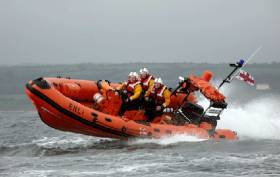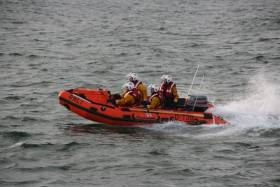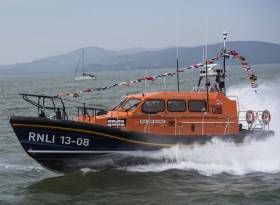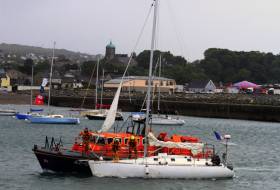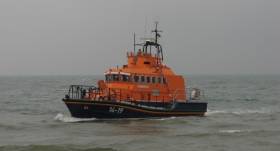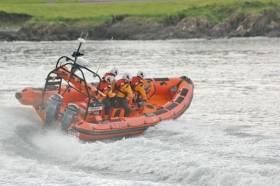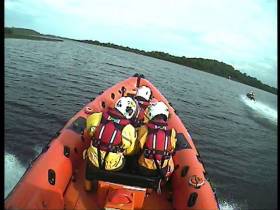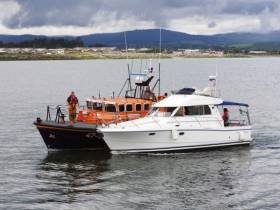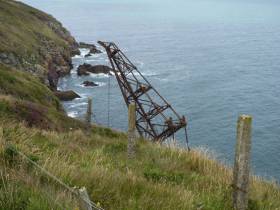Displaying items by tag: Lifeboats
Union Hall Lifeboat Launches To Yacht Off Glandore Harbour
#RNLI - Union Hall RNLI was tasked by Valentia Coast Guard at 6.14pm on Monday (20 June 2016) to reports of a yacht in difficulty with a broken tiller three-and-a-half miles south of Glandore Harbour.
The volunteer lifeboat crew launched at 6.20pm and on arrival at the scene they escorted the yacht to Eve Island before establishing a tow and continuing on Union Hall pier, where the yacht was tied up at 7.17pm.
Union Hall RNLI deputy launching authority Jim Moloney said: "There was no immediate danger to the yacht or the crew but they were right to request assistance as soon as their tiller broke."
Portrush Lifeboat Launches To Swimmer In Difficulty
#RNLI - Portrush RNLI's inshore lifeboat launched yesterday evening (Tuesday 21 June) to reports of a swimmer in difficulty at the Herring Pond in Portstewart.
Three volunteer lifeboat crew launched the inshore lifeboat in cloudy conditions in a slight sea swell towards Portstewart, where they observed a young adult male not making progress in the sea.
The swimmer had got very tired and was spotted by an onlooker who raised the alarm.
Quickly arriving on scene, the lifeboat crew got the casualty on board and took him the short distance to Portstewart Harbour where they handed him into the care of the coastguard.
Portrush RNLI lifeboat operations manager Robin Cardwell said: "The onlooker did exactly the right thing. The RNLI would rather be called out if there is a danger of someone being in difficulty in the water. That’s what we are trained to do.
"The Respect The Water campaign highlights the dangers of the cold water and how quickly it is to get into difficulties."
#RNLI - Arklow man and former lifeboat operations manager Jimmy Tyrrell will have the honour of naming the first class of RNLI lifeboat to be named after an Irish river this Saturday 25 June in Buncrana, Co Donegal.
Lough Swilly RNLI will hold the special naming ceremony and service of dedication from 11.30am to officially name the first Shannon-class lifeboat in Ireland, Derek Bullivant.
The Donegal lifeboat station was the first in Ireland to receive the new €2.4 million lifeboat, which is the most modern and technically advanced lifeboat in the RNLI fleet.
Shortly after its arrival on station, the lifeboat brought three local fishermen to safety after they had been reported missing when their vessel had lost power and drifted out to sea.
The lifeboat was funded by legacies from Derek Bullivant and Valerie Walker. Bullivant was born in Birmingham in 1922 and was a trained chemist before working as an industrial analyst for a company in the metal industry. He went on to start his own company which became one of the biggest aluminium recycling companies in the UK. He always wanted his success to benefit lifesaving and humanitarian charities which led him to provide a generous legacy which helped to fund the Lough Swilly lifeboat.
The second legacy was bequeathed from Valerie Walker from Portsmouth. Walker was a supporter of the RNLI and her legacy has been used to part fund the lifeboat. Her generosity will be remembered and acknowledged by a plaque which will be placed in the boathouse at Lough Swilly lifeboat station.
The Shannon is first class of lifeboat to be propelled by water jets instead of traditional propellers, making it the most agile and manoeuvrable all-weather lifeboat in the fleet.
Waterjets allow the vessel to operate in shallow waters and be intentionally beached. The lifeboat has a top speed of 25 knots and a range of 250 nautical miles, which makes it ideal for offshore searches and rescues in calm and rough seas.
The new lifeboat was developed to operate in the worst of sea conditions and is self-righting, automatically turning the right side up in the event of a capsize. Its unique hull is designed to minimise slamming of the boat in heavy seas and the shock-absorbing seats further protect the crew from impact when powering through the waves.
Commenting on the forthcoming occasion, Lough Swilly RNLI lifeboat operations manager John McCarter said: "Many people will know that we welcomed the lifeboat to Buncrana a little over a year ago but in grand RNLI tradition we officially name and dedicate the lifeboat after that and in doing so remember our generous benefactors who through their legacies have provided this incredible gift to our community.
"We are delighted that Jimmy Tyrrell will be officially naming our lifeboat. Our colleagues in the lifeboat community will know that Jimmy lobbied the RNLI for years to have a class of lifeboat named in recognition of the role Ireland and Irish lifeboat volunteers have played in the work of the charity for 192 years. All other lifeboat classes are named after UK rivers so the Shannon is truly an Irish lifeboat."
The Shannon lifeboat also has another strong Irish connection. Peter Eyre, an RNLI engineer from Derry who works at the charity’s headquarters in Poole, was instrumental in the development of the new lifeboat, designing the hull form at the age of 24.
The first all-weather lifeboat put on service in Lough Swilly was The Good Shepard in 2000.
Wicklow Lifeboat Assists Solo Sailor After Distress Call
#RNLI - Wicklow RNLI's all-weather lifeboat launched yesterday afternoon (Sunday 19 June) to a solo sailor in distress six miles off the Wicklow coast.
A marine VHF radio distress signal was received by the Irish Coast Guard from the French sailor on passage from France to Norway, when the twin rudder of his yacht suffered damaged and he was unable to steer the vessel.
The lifeboat was alongside the casualty 30 minutes after launch. Rescue 116, the Dublin-based coastguard helicopter was also tasked to the incident, remaining overhead while lifeboat volunteer Ciaran Doyle was transferred onto the yacht to assist the sailor with hauling an anchor and preparing a towline.
Weather conditions at the time had a rough sea state with a southerly Force 5-6 wind and good visibility.
With a towline established, the 10m yacht was taken back to Wicklow Harbour. Due to the conditions at the time, the journey took over 90 minutes as the line parted on three occasions.
The yacht was safely alongside the south quay at 5pm on Sunday evening.
Speaking after the callout, Wicklow RNLI lifeboat press officer Tommy Dover said: "Our coxswain Nick Keogh displayed great boat handling skills this afternoon in challenging conditions, while safely transferring a crewmember onto the yacht to assist the lone sailor."
This was the second callout over the weekend. On Saturday morning (18 June), during the Round Ireland Yacht Race, Wicklow RNLI helm Vinnie Mulvihill was busy preparing the inshore lifeboat for exercise when he heard shouts that someone was in the water near the East Pier.
Quick-thinking Mulvihill left the boat and entered the water to assist the woman after she slipped and fell in while going ashore from a moored boat.
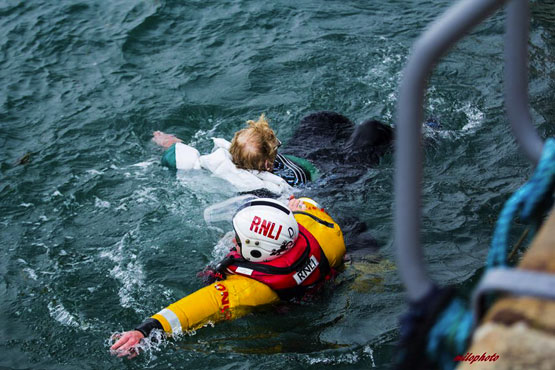
Woman rescued by Wicklow RNLI after she slipped into the harbour (Photo: RNLI/Milo Vanbeck)
He brought the women alongside a nearby boat and with the help of the occupants, she was taken out of the water and assessed at the lifeboat station by first aider Carol Flahive.
No further medical assistance was required and the woman left the station none the worse from her ordeal after a cup of tea and changing into dry clothes.
#RNLI - Arklow RNLI was called out early this morning (Sunday 19 June) to go the assistance of a casualty in difficulty near Arklow Harbour.
Within minutes of a pager alert at 6.23am, the lifeboat Ger Tigchlearr and her volunteer crew was launched to a report of a man in difficulty in the water outside the harbour.
As the lifeboat arrived on scene, a local fishing vessel had also come to the assistance of the casualty and had been trying with difficulty to get the man aboard the fishing boat.
The man was shortly thereafter recovered from the water by the fishermen and transferred to the Arklow lifeboat.
Casualty care was administered aboard the lifeboat, which then returned to station immediately to transfer the casualty to a waiting ambulance.
Following the callout, Arklow RNLI volunteer lifeboat press officer Mark Corcoran said: "We’re thankful to the skipper of the local fishing vessel for assistance in this rescue. Working together we were able to recover the casualty from the water. We would like to wish the casualty a speedy recovery."
#RNLI - Bangor RNLI assisted four people who got into difficulty on a broken-down motorboat on Belfast Lough on Monday evening (13 June).
The volunteer lifeboat crew launched at 10.25pm to rescue the 19ft motorboat just off the Cloghan Jetty.
The boat, with four people on board, had lost all power and was drifting in fog close to the shore.
Arriving at the scene, guided only by the light from a mobile phone, the crew of the relief Bangor lifeboat Tabby Cat took the motorboat under its control and returned it and its and crew safely to Carrickfergus Marina.
Speaking following the callout, Bangor RNLI helm Peter Semple said: :The crew and I are delighted that we were able to return these people to the safety of the marina. Although it was a calm night, it was dark, and Belfast Lough is not a great place to be if you can’t be seen.
"It is important to ensure that, if you lose all power you still have some way of being seen and making contact with the shore."
In other news from Bangor, the lifeboat station was recently visited by a man rescued a fortnight ago by one of its volunteers after he suffered a heart attack at sea.
Tim Bailie was on a weekend pleasure cruise between Carrickfergus and Bangor with his family at the end of May when he was taken ill.
But thanks to the quick action of helm Kyle Edwards and his crew, Bailie is still here to tell the tale in his own words, as per the video below:
#RNLI - Carrybridge RNLI attended three different incidents – one involving a fire – on Upper Lough Erne this past Saturday (11 June).
The inshore lifeboat and rescue wafer craft were initially tasked to a burning vessel at 6.08pm, two miles north of Belturbet. Both Belturbet and the NI Fire and Rescue Service were in attendance.
The four people onboard were safely removed from the boat by a passing vessel and brought to shore. The 25ft Bayliner later burnt itself out and sank into shallow waters close to the shoreline.
The volunteer crew were then tasked by Belfast Coastguard to a boat with engine problems 1.5 miles from Knockninny. The sports cabin cruiser and its four passengers and their dog were brought to safety at Knockninny Marina.
The third tasking saw Carrybridge RNLI going to a vessel that ran out fuel close to the Share Centre. The 22ft vessel and its passenger were brought to safety of the Share Centre Marina.
The lifeboat and rescue craft returned to station at 9.15pm.
Speaking following the callouts, Carrybridge RNLI helm Chris Cathcart said: "The crew of the burning vessel did the right thing by alerting the coastguard straight way when their vessel went on fire.
"They made sure they had their lifejackets on and evacuated their vessel to another passing vessel as soon as possible."
Cathcart also commended the crews of the further two vessels the lifeboat assisted for their quick thinking when they found themselves in danger.
"The importance of alerting the coastguard as soon as possible in all cases help saves lives and prevented the situation from developing into something more serious on all our callouts."
The busy evening for the volunteer crew was in the first weekend of the RNLI’s summer campaign #RespectTheWater that targets accidental drowning along Northern Ireland’s coastline and inland waterways.
Respect the Water urges the public to watch out for the key dangers that can catch people out in or near the water. The campaign which will run throughout the summer months aims to highlight the risk of accidental drowning when people are near the water’s edge while encouraging safer behaviour both in and around the water.
Wicklow Lifeboat Assists Five On Motor Cruiser
#RNLI - Wicklow RNLI's all-weather lifeboat launched to give assistance to an English motor cruiser at 12.20pm yesterday (Sunday 12 June).
The cruiser, with five people on board, was on passage from Dun Laoghaire to Pembroke when it developed mechanical problems four miles south of Wicklow Harbour.
Just 15 minutes later, the lifeboat, under the command of coxswain Nick Keogh, was alongside the drifting cruiser. A towline was established and the volunteer crew brought the cruiser back to Wicklow.
This was the second callout out of the week for the Wicklow RNLI crew. On Wednesday morning, the all-weather lifeboat launched to assist a French yacht with three people on board that had its propeller fouled by a rope.
The crew of the yacht managed to free the rope obstruction and the lifeboat stood by until the yacht was able to resume its passage south.
Next Friday 17 June, Wicklow RNLI will hold a lifejacket clinic at the lifeboat station from 11am to 4pm in conjunction with the Round Ireland Sailfest.
Anyone who owns a lifejacket is encouraged to bring it along for a free check. Advice will also be available with tips on how to choose, fit and maintain your lifejacket.
Man Dies While Diving Off Waterford Coast
#Diving - A man has died after getting into difficulty while diving off Ardmore in Co Waterford yesterday afternoon (Sunday 12 June).
Youghal RNLI's volunteer lifeboat crew were tasked to the incident between Goat Island and Ram Head near Ardmore, Co Waterford before 4.30pm.
On arrival they found a man in the water who they recovered onto the lifeboat, and immediately administered casualty care.
Working with Helvick Head RNLI, who were also on scene, the casualty was winched onto the Irish Coast Guard helicopter Rescue 117 and brought to Waterford University Hospital, where he was later pronounced dead, as the Irish Examiner reports.
A spokesperson for Helvick Head RNLI that a second diver who had been with the deceased had managed to swim to shore to raise the alarm, allowing for a swift emergency response.
Commenting on the callout, Youghal RNLI lifeboat operations manager Fergus Hopkins said: "This was a difficult callout for everyone concerned and our thoughts are with the family of the man who was taken from the water this afternoon."
Portaferry Lifeboat Rescues Three Lost In Thick Fog
#RNLI - Volunteers with Portaferry RNLI went to the aid of three men on board a 4m dory who had become lost in thick fog close to Ballyhornan on the Co Down coast on Thursday (9 June).
At the time of launch at 4.45pm, the weather was extremely foggy with very poor visibility, a Force 2 southerly wind and smooth sea conditions.
The three men had become lost in the worsening conditions and were unsure of their exact location. Rather than try and guess their location, they called emergency services for help, giving a rough position as somewhere between Sheepland Harbour and Guns Island, just off the Co Down coast.
Portaferry RNLI headed towards the men’s general location and at first passed the three men in the thick fog. On arrival at Sheepland Harbour, however, the lifeboat crew started to track back towards Guns Island.
By this time the men on board the lost vessel had called the coastguard once more to report that they had heard the engines of the lifeboat passing by, helping to pinpoint their location.
The lifeboat crew arrived on scene close to Guns Island at 5.15pm, attaching a tow rope and proceeding to tow the boat into Ballyhornan Bay, where the three men went safely ashore before the lifeboat returned to station.
Following on the rescue, Portaferry RNLI lifeboat operations manager Brian Bailie said: "The three men made the correct decision when they called for help.
"They had become lost and disorientated in thick fog and rather than try to blindly find their own way to shore, they called for help and remained in the area they last believed they were.
"This made our job a lot easier and I am delighted that our volunteer crew have helped bring these men safely to shore."




























